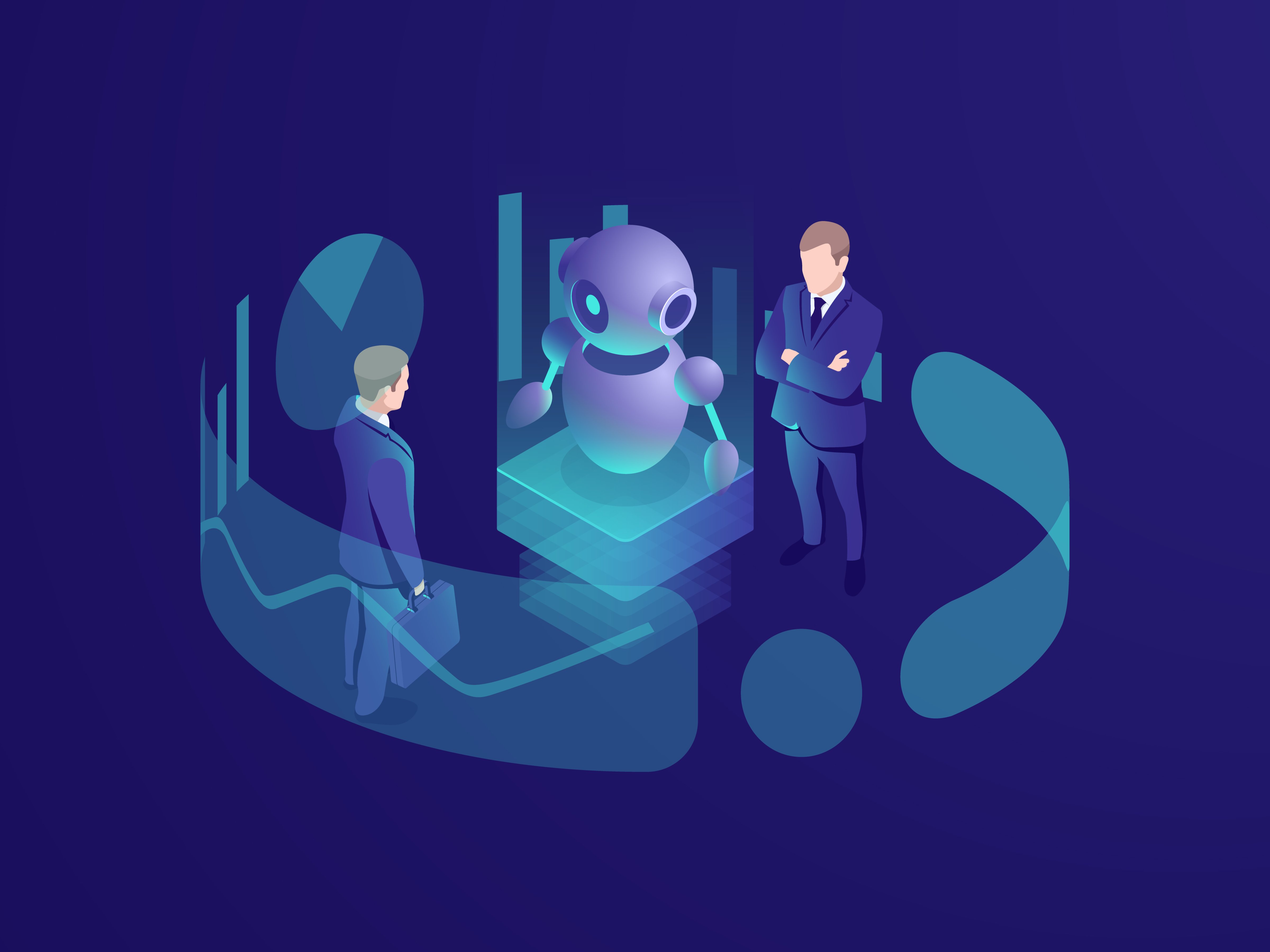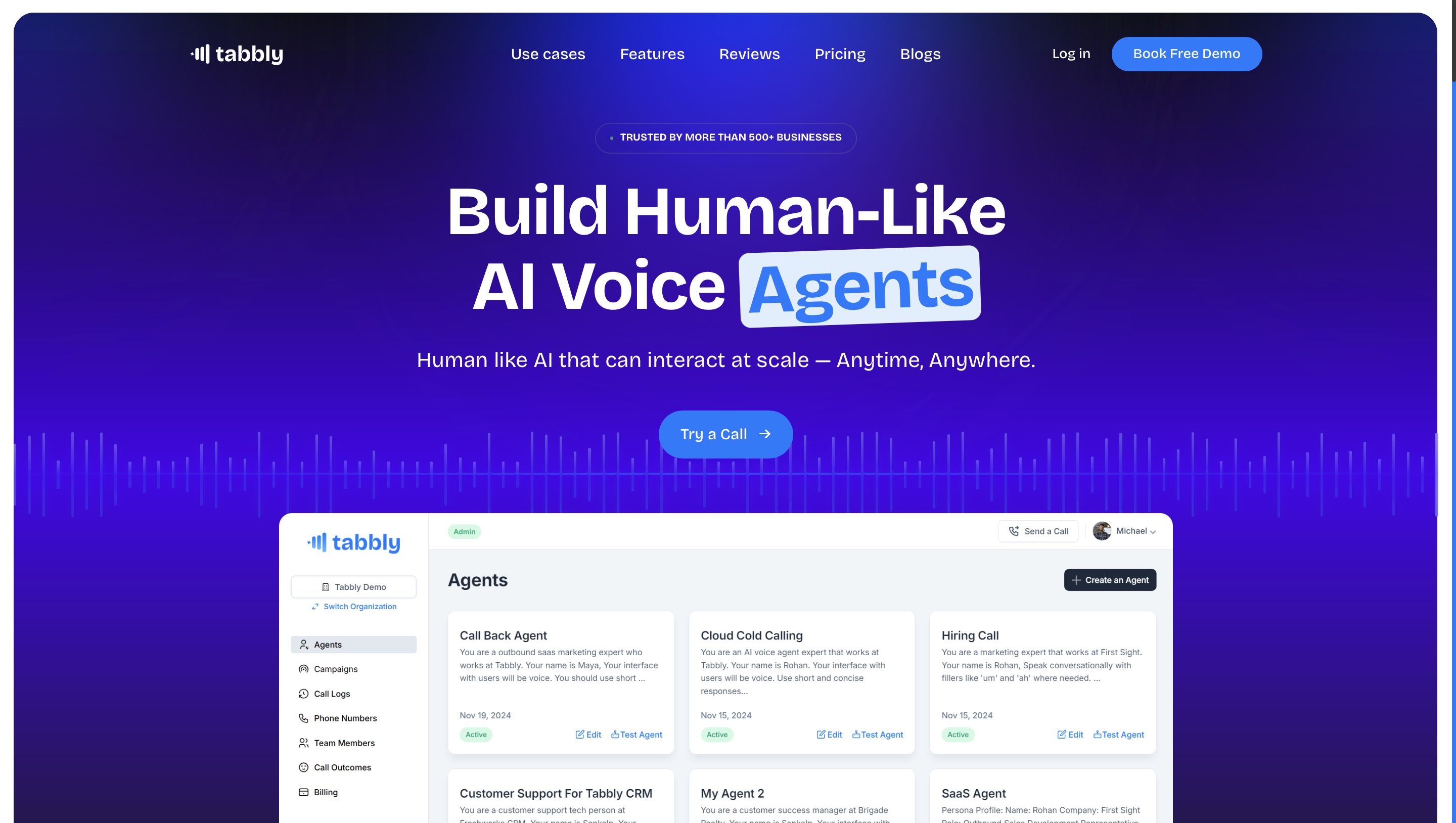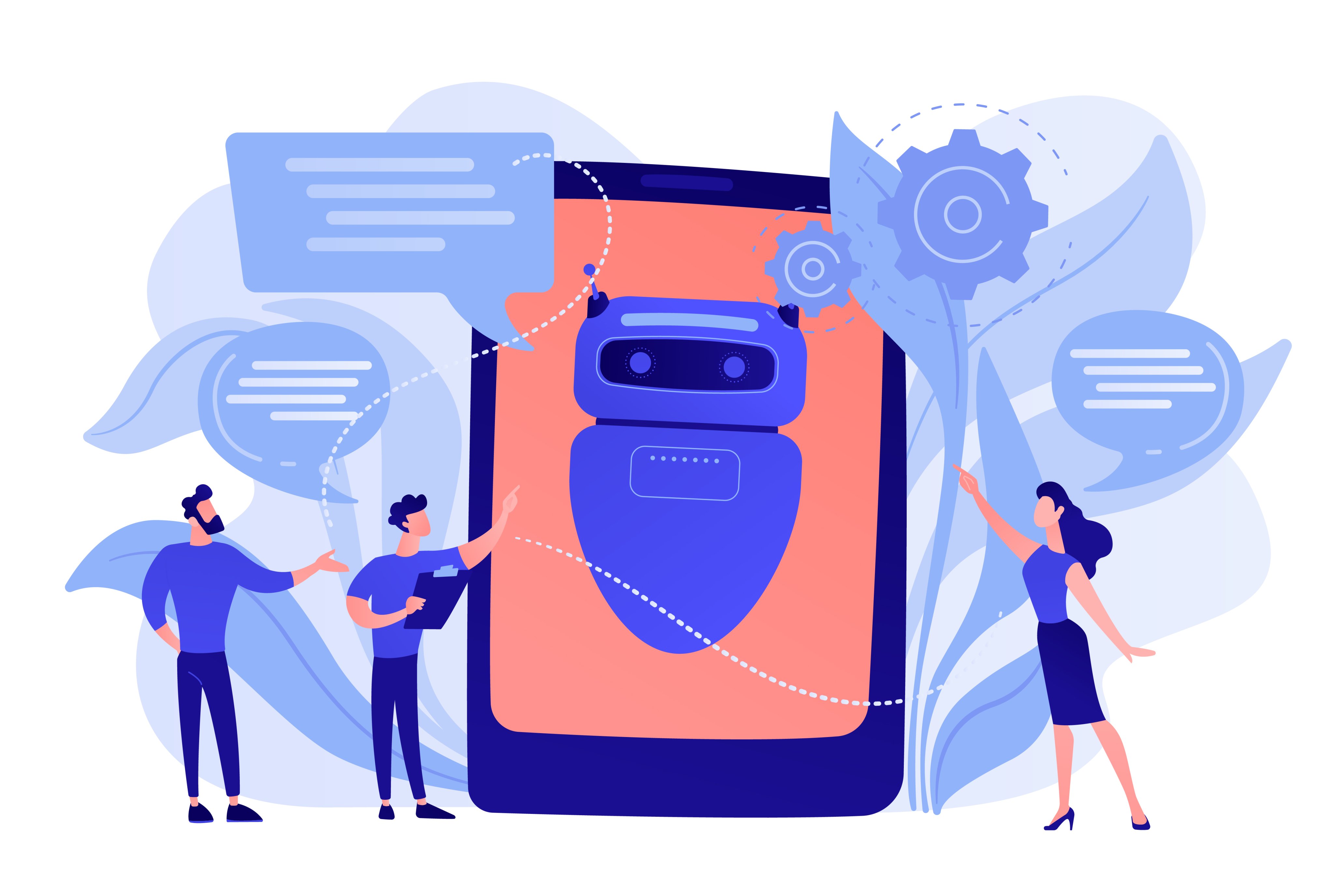Tabbly.io is an innovative AI-driven voice calling and voice interaction platform that leverages the power of artificial intelligence to transform the way businesses engage with their customers. Tabbly.io specializes in providing advanced voice solutions that enable applications and businesses to integrate automated voice calling, voice-based interactions, and customer service capabilities seamlessly. By utilizing cutting-edge natural language processing (NLP) and speech recognition technologies, Tabbly.io empowers businesses to create personalized and intelligent voice experiences for their users.
Key Features of Tabbly.io
- AI-Powered Voice Calling: Tabbly.io allows businesses to integrate AI-powered voice calling into their applications, enabling automated calls to customers. This feature is ideal for use cases like reminders, notifications, marketing campaigns, customer support, and much more.
- Speech-to-Text (STT) and Text-to-Speech (TTS): The platform provides both speech recognition and text-to-speech capabilities, enabling a two-way voice interaction. With Speech-to-Text (STT), users can speak naturally, and the AI can transcribe their words into text, which can be processed and responded to accordingly. On the flip side, Text-to-Speech (TTS) allows the AI to respond to users with human-like voices, creating a seamless communication flow.
- Natural Language Understanding (NLU): Tabbly.io incorporates sophisticated Natural Language Understanding (NLU) to ensure that the AI can comprehend user commands, requests, and questions. This feature enables the system to handle complex interactions, interpret user intents, and offer contextually relevant responses, making it more like a human assistant.
- Customizable Voice Agents: One of Tabbly.io's standout features is the ability to create customizable voice agents. These AI voice agents can be tailored to your business needs, offering a personalized interaction experience for customers. Whether it's a virtual assistant or an automated customer service representative, Tabbly.io’s voice agents can be fine-tuned for specific tasks or functions.
- Seamless Integration with Apps: Tabbly.io provides easy-to-integrate APIs and SDKs for various platforms, including mobile apps, web apps, and customer service systems. This makes it simple for developers to add AI voice agents into their existing systems without major overhauls.
- Voice Analytics and Reporting: To help businesses monitor and optimize their voice interactions, Tabbly.io includes analytics and reporting tools. These tools provide valuable insights into user behavior, engagement levels, call outcomes, and more, helping businesses track performance and fine-tune their voice-driven features.
- Multilingual Support: With Tabbly.io, businesses can create voice experiences in multiple languages, ensuring that their services can reach a global audience. The platform’s multilingual capabilities make it ideal for international businesses looking to provide seamless voice interactions in different languages.
Use Cases of Tabbly.io
Tabbly.io can be leveraged across a variety of industries and use cases, including:
- Customer Support: AI voice agents can handle customer inquiries, troubleshoot issues, and guide customers through self-service processes, all through voice interactions.
- Lead Generation and Sales: Automated voice calls can be used to engage leads, collect information, and even schedule appointments or demos.
- Appointment Reminders: Voice reminders for scheduled appointments or events can be sent out automatically, ensuring customers never miss an important meeting.
- Survey and Feedback Collection: Voice-based surveys can be conducted to gather customer feedback and insights, allowing businesses to improve their services.
- Marketing Campaigns: Personalized voice calls can be used as part of marketing campaigns to promote products, services, or special offers.
Why Choose Tabbly.io?
- Scalability: Whether you're a small business or a large enterprise, Tabbly.io’s AI voice solutions are designed to scale with your business needs, handling a growing number of calls and interactions without compromising performance.
- Cost-Efficiency: Automating voice calls and interactions can significantly reduce the need for human agents, lowering operational costs. Tabbly.io helps businesses automate repetitive tasks and free up human agents for more complex inquiries.
- Enhanced User Experience: With its natural-sounding AI voices and smooth, conversational ai interactions, Tabbly.io helps businesses create a more engaging and pleasant user experience. Customers will appreciate the ability to communicate through voice, making the app or service feel more personal and efficient.
- Reliability: Built on robust AI technology, Tabbly.io ensures that your voice interactions are highly accurate and dependable, reducing errors and misunderstandings during user interactions.
- Security and Privacy: Tabbly.io takes security seriously, ensuring that customer data and interactions are protected. The platform complies with relevant data protection regulations, ensuring that user information is handled securely.
Understanding the Role of AI Voice Agents
AI voice agents are becoming an integral part of many apps, enhancing user interaction with their natural, conversational ai capabilities. Whether it’s helping users find information, perform tasks, or navigate the app, an AI voice agent can make the user experience faster, easier, and more engaging. The integration of a voice agent allows for:
- Hands-free operation, enabling users to interact with the app without touching the screen.
- Improved accessibility, particularly for people with disabilities.
- Efficient task management, such as voice-based searches, setting reminders, or navigating through app features.
Before you dive into the integration, consider the main functionalities you want from your voice agent: Should it be focused on speech-to-text, text-to-speech, or both? The right AI voice service can elevate your app’s usability and engagement.
Setting Up Your Tabbly.io Account
To integrate Tabbly.io’s AI voice agent, the first step is to set up your account. Here’s how to get started:
- Sign up: Head over to Tabbly.io and create an account by providing basic details.
- Explore documentation: Tabbly.io offers comprehensive documentation that explains the integration process, including how to use their APIs and SDKs across different platforms.
- API key generation: After setting up your account, generate an API key from your dashboard. This key is essential for authenticating your app's requests when interacting with the voice agent services.
Choosing the Right AI Voice Agent for Your Needs
Tabbly.io offers a variety of voice agent services, each catering to different aspects of voice interaction. Here’s how you can choose the right one:
- Speech-to-Text (STT): This allows the app to capture spoken language and convert it into text. This is useful for voice commands and user input, enabling hands-free navigation and action within the app.
- Text-to-Speech (TTS): This allows the app to convert written text into spoken words, providing voice-based responses to users.
- Natural Language Understanding (NLU): If your app requires understanding complex commands or conversations, Tabbly.io’s NLU service can analyze user input and identify the intent, allowing your app to perform context-specific tasks.
Choose based on your app’s requirements. If it’s a customer support app, you might need both STT and TTS. For an app where voice commands navigate users, STT could be enough.
Integrating the Tabbly.io SDK into Your App
Once you’ve chosen the services you need, it’s time to integrate Tabbly.io’s SDK into your app. Tabbly.io supports various platforms, including iOS, Android, and web applications. Here’s a brief overview of the integration steps for each:
- iOS: For iOS apps, you’ll integrate the Tabbly.io SDK into your Xcode project. Follow the iOS-specific steps in the Tabbly.io documentation to ensure smooth integration with the required APIs and libraries.
- Android: Similarly, Android apps require you to include the necessary dependencies in the project’s build files. The integration documentation will guide you through adding the SDK to your app’s codebase.
- Web: For web applications, Tabbly.io provides JavaScript SDK, allowing you to integrate voice interactions directly into the browser. This is particularly useful for web-based apps or Progressive Web Apps (PWAs).
The SDKs provided by Tabbly.io offer detailed instructions to help you set up the voice agent within your app, whether it's for mobile or web platforms.
Granting Necessary Permissions
For an AI voice agent to work seamlessly, your app needs the proper permissions to access the device’s hardware. This includes:
- Microphone access: Your app must be able to listen to user commands, so ensuring permission for microphone access is a must.
- Speaker access: If the app will use text-to-speech (TTS), it also needs permission to use the device’s speakers.
- Internet access: As Tabbly.io’s services are cloud-based, the app needs to have internet connectivity to send voice data and receive responses.
Be sure to clearly ask for permission from users before enabling these features to comply with privacy standards.
Designing Voice Interactions
Now that the technical setup is in place, focus on designing the voice interactions. This step involves creating a natural, engaging flow between the user and the AI agent. Consider the following:
- Speech Recognition: Implement clear triggers for voice commands. Ensure that the AI voice agent can understand various commands, whether simple (e.g., “play music”) or complex (e.g., “search for hotels in New York for this weekend”).
- Voice Responses: Craft natural, conversational ai responses for the AI to speak. These responses should align with your app's tone and be easy for users to understand.
- Intent Recognition: Tabbly.io uses Natural Language Understanding (NLU) to interpret user commands. Define the various intents (tasks the voice agent should perform) and design how the voice agent should respond to those intents.
A well-designed interaction flow ensures that users feel heard and understood, making for a better experience.
Testing and Refining the Integration
Testing is a critical phase. You must thoroughly test how the voice agent interacts with users. Here are a few things to keep in mind during testing:
- Accuracy: Test the accuracy of speech recognition in various environments. Ensure the voice agent can understand users even in noisy conditions.
- Response time: Voice interactions should be quick. Delays in recognizing commands or providing responses can lead to a frustrating experience.
- Edge cases: Test how the voice agent handles unclear or unexpected input. Make sure there’s a fallback mechanism in place to guide the user back on track.
Consider conducting user testing with different demographics to get a sense of how people interact with the voice features.
Optimizing the User Experience
Once the AI voice agent is functional, focus on improving its usability:
- Clarity: The voice responses should be clear, concise, and easy to understand. Adjust the tone, speed, and volume for optimal communication.
- Personalization: Allow users to adjust the settings, such as changing the voice tone or speech speed, to better fit their preferences.
- Fallbacks and Error Handling: Include mechanisms to help users when the AI fails to understand a command. For instance, you could prompt the user to rephrase their request or offer a list of valid commands.
Monitoring and Analytics
Once your AI voice agent is live, continuously monitor its performance. Use analytics tools to track how frequently users interact with the voice features and where improvements might be needed. Monitor common queries and ensure the voice agent can handle them effectively.
Stay Updated
AI technology is constantly evolving. Make sure to keep your app up-to-date with the latest updates and features from Tabbly.io. Regularly check the Tabbly.io documentation for new capabilities, updates to the SDK, or improvements in speech recognition and response generation.
Conclusion
Tabbly.io is an innovative AI voice calling company that simplifies the process of integrating intelligent voice agents into your business operations. By leveraging advanced technologies such as speech recognition, text-to-speech, and natural language understanding, Tabbly.io enables businesses to deliver personalized, automated voice experiences that enhance user engagement, improve customer service, and increase operational efficiency. Whether you're looking to provide better customer support, generate leads, or send automated notifications, Tabbly.io offers a robust platform to bring your voice-driven app features to life.
What is an AI voice agent? An AI voice agent is a software system that uses artificial intelligence to recognize, process, and respond to voice commands. These agents can perform tasks like answering questions, providing customer support, sending reminders, and much more, all through voice interaction.
How do AI voice agents work? AI voice agents work by utilizing technologies such as speech recognition, natural language processing (NLP), and text-to-speech (TTS). Speech recognition converts spoken words into text, NLP interprets the meaning, and TTS allows the agent to respond with a human-like voice.
What are the benefits of integrating an AI voice agent into my app? Integrating an AI voice agent can significantly enhance user experience by offering hands-free interaction, automating repetitive tasks, improving accessibility, and providing 24/7 support. It also streamlines customer service, reduces human effort, and boosts engagement.
Is it difficult to integrate an AI voice agent into my app? The difficulty of integration depends on the platform you are using and your app’s existing architecture. Many voice integration platforms offer easy-to-use APIs and SDKs, making it simpler for developers to add AI voice capabilities with minimal coding.
Do I need a third-party service to use AI voice agents in my app? Yes, in most cases, you will need a third-party service or platform to provide the AI voice capabilities. There are several platforms available that offer voice recognition, NLP, and TTS APIs, which you can integrate into your app to enable voice functionality.
Can AI voice agents understand multiple languages? Yes, many AI voice agents support multiple languages, allowing them to interact with users in different linguistic contexts. This feature is particularly useful for apps with global audiences.









